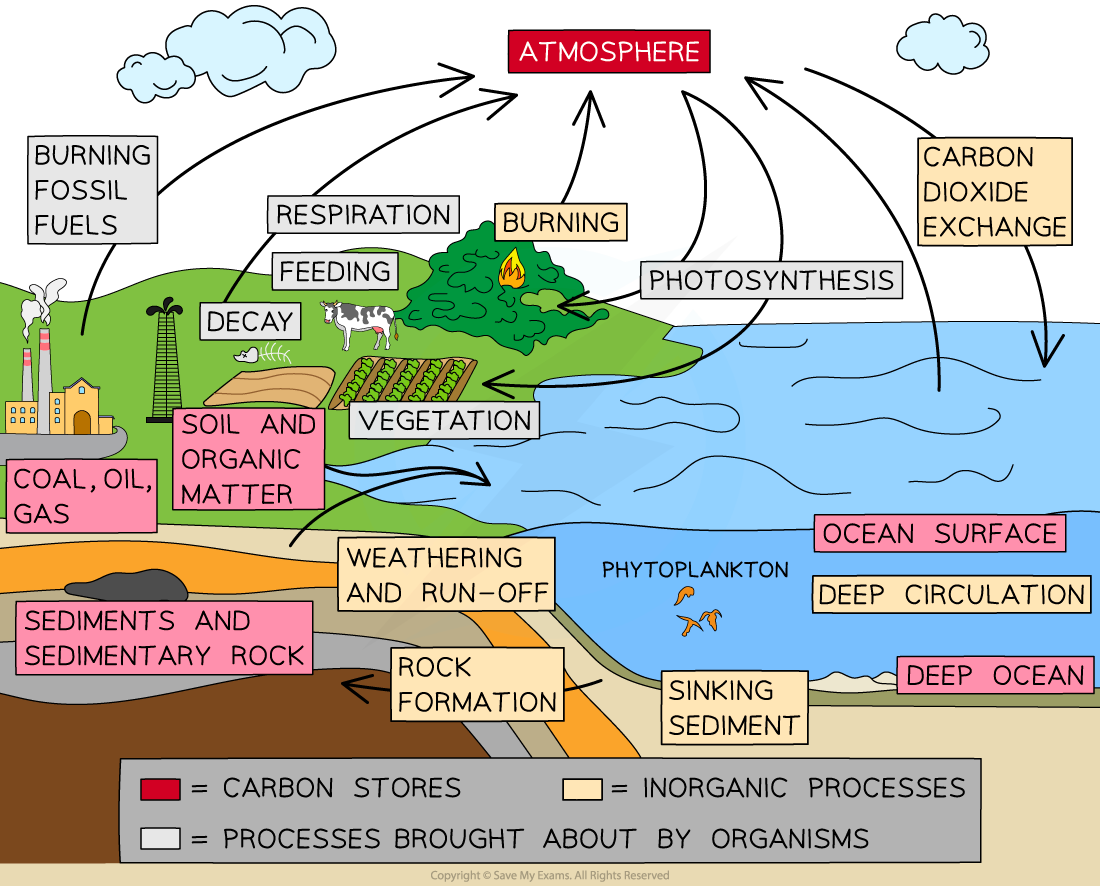The carbon cycle
Carbon is constantly being recycled around the biosphere so that the number of carbon atoms in the biosphere is essentially constant; carbon atoms merely swap from one compound to another by the various processes in the carbon cycle
Carbon is stored in various forms:
In the atmosphere (as CO2)
In sedimentary rocks
In fossil fuels like coal, oil, and gas; coal is almost pure carbon
In soil and other organic matter
In vegetation (e.g. as cellulose)
Dissolved in the oceans (as CO2)
Photosynthesis
Autotrophs use the energy of sunlight to 'fix' carbon dioxide, turning its carbon into sugars and other organic molecules
This removes carbon from the atmosphere
The Calvin cycle is where CO2 is fixed, by the enzyme Rubisco, which carboxylates RuBP
Terrestrial plants use gaseous CO2 directly from the air
Aquatic organisms use CO2 dissolved in water
As much CO2 is fixed from ocean microorganisms, as from terrestrial plants
Sedimentation
Plants that die are not fully decomposed by saprobionts; their bodies form layers of sediment that can accumulate over millions of years, locking carbon into the ground
This sediment is a store of energy and can form fossil fuels like peat and coal
Aquatic organisms that die also form sediments on the sea bed; these can go on to form other fossil fuels like oil and gas
Shells and other calcium-containing body parts can form sedimentary rocks such as limestone
The existence of life forms over billions of years has shaped the biosphere, in that their remains are still being recycled
Respiration
All life forms respire, including autotrophs
Heterotrophs rely on respiration for all their energy needs
Respiration puts CO2 into the atmosphere, in the opposite direction to photosynthesis
CO2 is released in the Link Reaction and the Krebs Cycle of aerobic respiration
Anaerobic respiration also releases CO2 into the atmosphere, via fermentation by yeast, moulds and bacteria
Feeding
Carbon is passed from autotroph to heterotroph during feeding
Carbon is also passed from primary consumer to secondary consumer
Biomass transfer always includes the transfer of carbon, the main element in biomass
Decay & Decomposition
Dead plants and animals are fed upon by detritivores and decayed by saprophytes
Releasing carbon into the surroundings
Supplying carbon to the detritivores
Supplying carbon to the saprophytes
Waste matter such as faeces and urine is used by decaying saprobionts
Such processes can release CO2 back into the air

Burning fossil fuels
Since the mid 19th century, humans have extracted and burned increasing amounts of fossil fuels from the Earth
CO2 is being returned to the atmosphere faster than it can be absorbed by plants and aquatic producers
The CO2 level in the atmosphere is approximately double that of 800,000 years ago
Warmer temperatures mean that less CO2 can be dissolved in the oceans, so is released into the air
This has caused dramatic climate change and affected many other species, mainly through changing habitats
Methane
Produced when decomposers break down dead remains of organisms, and when microbes in primary consumers digest food that has been eaten
Levels have more than doubled in the past 150 years due to:
More extraction of fossil fuels
More decaying waste
More cattle
Natural stores such as frozen ground thawed
The greenhouse effect
Heat from the sun is reflected from the Earth’s surface
When it reaches the atmosphere some rays pass through
Other rays are trapped in by green house gases (carbon dioxide)